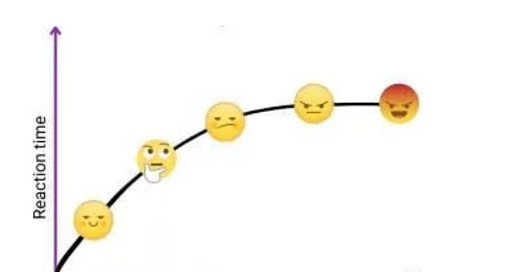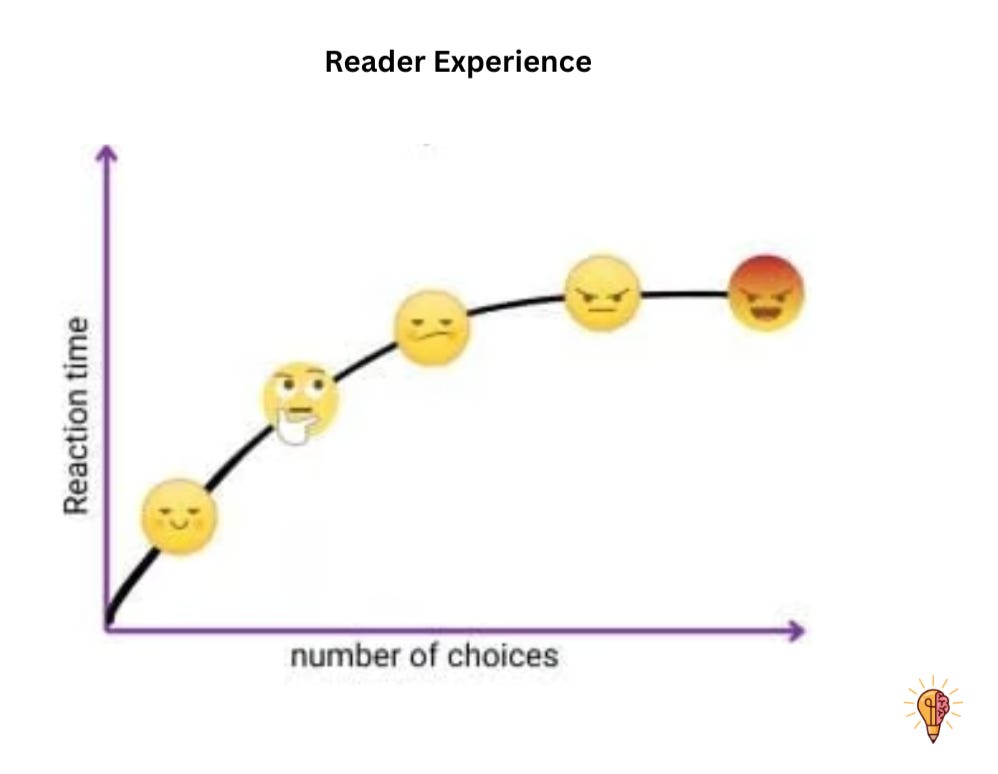Applying Hick’s Law to Write Better 🧠
How minimizing reader decisions makes writing more powerful 💪
You're at a supermarket. And you see two tables with jam samples. One with 24 varieties and another with just 6. Which one will you go to?
Most of us would rush to the table with more options. Because more choices mean better chances of finding something we love, right?
That's what most people did in a famous experiment by psychologists Sheena Iyengar and Mark Lepper. 60% (out of 242) stopped at the table with 24 jams, while only 40% (out of 260) stopped the next day at the one with 6.
But here's where things get interesting.
With 24 jams, even though the traffic was higher, only 3% (4 people) actually bought anything. On the other hand, at the table with 6 jams, a whopping 30% (31 people) made a purchase.
Counterintuitively, fewer jam choices made the decision simpler. The more options people had, the harder it became to choose.
Hick’s Law: Why More Isn’t Necessarily Better
Turns out, this isn’t just about jams, this pattern has been fundamental to human behavior.
Back in 1952, psychologists William Hick and Ray Hyman found something interesting about how our brains respond to choices. When presented with multiple stimuli (like buttons to press or options to choose), our reaction time doesn't just increase slightly, it grows logarithmically with each new choice.
They created a formula for this: RT = a + b log2(n)
Sounds complicated? Let's break it down with a simple example from a TV remote:
Say you're trying to change the channel. RT or reaction time is how long it takes you to press the right button, 'a' is the basic time you need to realize you want to change channels, 'b' is how long you take to process each number, and 'n' is how many buttons you're choosing from.
With an old TV (just volume and channel buttons), you decide instantly. With today's remote (50+ buttons for smart TV, streaming, recording, settings), your brain has to process each possibility, and your decision time multiplies.
Here’s why this happens:
Think of your brain like a computer with limited RAM. Just like a computer slows down when too many programs are running, your working memory can only hold about 4-7 pieces of information at once. After that, things start falling out.
That's Hick's Law in action.
Applying Hick’s Law to Writing
So what does all this mean for us as writers? Every word, sentence, and paragraph we put down is asking our readers to make choices. Which ideas to focus on? What matters most? Where is this going?
Just like those jam buyers, our readers can get overwhelmed. The more options we throw at them, the harder it becomes for them to process our message.
The good news? We can use Hick's Law to make our writing clearer and more effective. Here are five ways to do it:
Tip 1: Choose Simple Over Sophisticated Language
Why say "utilize" when you can say "use"?
Why write "commence" when you can write "start"?
Complex words don't make your writing better. They just add to your reader's cognitive load.
Think of it this way: each sophisticated word is like adding another jam flavor. Sure, it might make you look fancy, but it's making your reader work harder to understand your message.
❌ The methodology utilized for implementing this initiative facilitated the enhancement of organizational efficacy.
✅ This method helped improve how the company works.
Same meaning, less mental effort. Your readers will thank you.
Tip 2: Less Words, More Impact
Writers have long known that constraints breed creativity. Think of Haikus (17 syllables to reflect on nature), or sonnets (14 lines to express complex themes).
These structured formats force writers to choose words carefully. When choices are limited, every word must earn its place.
Let’s try it with everyday writing:
❌ "We are writing to inform you that due to circumstances beyond our control, we regret to announce that there will be a temporary pause in our regular service delivery for a brief period of time."
✅ "Our service will pause for two days."
See the difference? When you cut the clutter, your message becomes clearer.
Tip 3: One Idea, One Paragraph
Every paragraph should express one clear thought. When you pack multiple ideas into a single space, you're making your reader juggle too many concepts at once.
Let's see how this works:
❌ Our coffee machine brews perfect coffee. It's also energy efficient. The design won awards. It comes with a warranty. Free shipping available.
✅ Our coffee machine brews perfect coffee. Every cup comes out rich and flavorful.
It's built to last, backed by a 5-year warranty.
The sleek design has won multiple awards.
Get free delivery to your door.
See how each paragraph now focuses on one clear aspect – quality, durability, design, and offer?
Tip 4: Lead With What Matters and Reveal Details Progressively
Just like a news article leads with the headline before diving into details, your writing should start with what your reader needs most.
Think of it as a pyramid—most important information at the top, supporting details below. This way, readers get the key message even if they don't read everything.
❌ We've been in business for 20 years, have won multiple awards, and have a dedicated team of experts. After careful consideration and market research, we've decided to launch a new product line. Starting next month, we're introducing our smart fitness tracker.
✅ We're excited to launch our smart fitness tracker next month.
It's the newest addition to our award-winning product line, backed by 20 years of expertise.
See how the second version puts the key information upfront? No one has to search for the main point.
Tip 5: Group Related Ideas
Our brains naturally look for patterns. When ideas are scattered randomly, readers waste mental energy trying to connect the dots.
❌ Sign up for our newsletter to get recipes. Learn knife skills. Get weekly meal plans. Master baking techniques. Receive shopping lists. Get plating tips. Join our cooking workshops.
✅ Learn to cook: master cooking basics and baking fundamentals.
Plan your meals: get weekly recipes, meal plans, and shopping lists.
Subscribe to our newsletter for weekly cooking tips and recipes.
See how grouping creates instant clarity? Instead of a random list, readers see clear categories with a focused action step.
-------
With Hick’s Law, you’re making life easier for your reader. Remember, sometimes less is more.






Great article! Fully agree that more choice doesn’t always lead to better decisions. Through the jam experiment and Hick’s Law, it illustrates how overwhelming options can lead to paralysis rather than action. The lesson is clear: clarity and simplicity are not just preferences but necessities, whether in decision-making, design, or writing.
For writers, this is a wake-up call. Readers don’t crave complexity; they crave understanding. Every unnecessary word, every convoluted sentence, is another “jam flavor” making their cognitive load heavier. So the takeaway is to say less, but say it better. Lead with what matters, simplify where you can, and trust that clarity, not complexity, is what leaves a lasting impact.
Super nice article! Thank you!